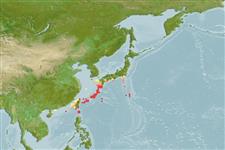>
Blenniiformes (Blennies) >
Blenniidae (Combtooth blennies) > Salariinae
Etymology: Cirripectes: Latin, cirrus = curl fringe + Greek, pektos, -e, -on = made of several parts solidly united (Ref. 45335); imitator: Specific epithet meaning 'mimic', referring to the similarity of the color pattern to that of C. polyzona and C. castaneus..
Environment: milieu / climate zone / depth range / distribution range
Ecologia
marinhas associadas(os) a recifes; intervalo de profundidade 0 - 10 m. Tropical; 35°N - 20°N
Western Pacific: Shirahama, Japan and the Ogasawara Islands to Batan Islands, northern Philippines.
Length at first maturity / Tamanho / Peso / Idade
Maturity: Lm ?, range 6 - ? cm
Max length : 9.3 cm SL macho/indeterminado; (Ref. 529)
Espinhos dorsais (total): 11 - 13; Raios dorsais moles (total): 13-15; Espinhos anais 2; Raios anais moles: 14 - 16; Vértebras: 30. Diagnosis: Dorsal fin XII, 14, membrane attached to caudal fin, with deep notch above last spine, first spine almost same or slightly higher than second; anal fin II, 15; pectoral rays 15; pelvic fin I, 4; caudal fin procurrent rays 11-14. Vertebrae 10 + 20. LL, without scales and scalelike flaps; LL tubes 7-14, canal ends below posterior to 9th dorsal ray, usually on caudal-fin base. Lower lip smooth mesially, plicate laterally. Upper lip crenulae 36-50. Gill rakers 24-27. Cephalic sensory pore system complex. Cirri, nuchal 40-59, supraorbital 13-46, nasal 9-93; 4 groups of nuchal cirri, 2 groups on 1 side rarely connected by a low basal membrane, ventralmost group on each side borne on enlarged nuchal flap. Body depth at anal-fin origin 3.5-4.0 in SL. Morphometric and meristic characters does not vary geographically. Overall dark brown; female with pale grey polygonal spots; male with irregular bars and yellow tips on caudal fin and anterior dorsal spines; irregular pupil- sized spots on head; iris with yellow-ringed pupil (Ref. 529, 90102).
Facultative air-breathing in the genus (Ref. 126274); Adults inhabit shallow coral and rocky reefs (Ref. 90102). Oviparous. Eggs are demersal and adhesive (Ref. 205), and are attached to the substrate via a filamentous, adhesive pad or pedestal (Ref. 94114). Larvae are planktonic, often found in shallow, coastal waters (Ref. 94114).
Life cycle and mating behavior
Maturidade | Reprodução | Desova | Ovos | Fecundidade | Larvas
Oviparous, distinct pairing (Ref. 205). Urogenital orifice of male genital papilla located basally between 2 widely separated slender filaments on a fleshy swelling behind anus; testes bulbous with length equal to its width (Ref. 529).
Williams, J.T., 1988. Revision and phylogenetic relationships of the blenniid fish genus Cirripectes. Indo-Pac. Fish. (17):78 p. (Ref. 529)
Categoria na Lista Vermelha da IUCN (Ref. 130435)
Ameaça para o homem
Harmless
Utilização humana
Pescarias: sem interesse
Mais informação
ReferênciasAquaculturaPerfil para aquaculturaEstirpesGenéticaElectrophoresesHereditariedadeDoençasProcessamentoNutrientsMass conversion
ColaboradoresFotografiasStamps, Coins Misc.SonsCiguateraVelocidadeTipo de nataçãoÁrea branquialOutras referênciasCérebrosVisão
Ferramentas
Relatórios especiais
Descarregue XML
Fontes da internet
Estimates based on models
Preferred temperature (Ref.
123201): 22.7 - 26.9, mean 25.2 °C (based on 102 cells).
Phylogenetic diversity index (Ref.
82804): PD
50 = 0.5000 [Uniqueness, from 0.5 = low to 2.0 = high].
Bayesian length-weight: a=0.01072 (0.00480 - 0.02393), b=3.01 (2.82 - 3.20), in cm total length, based on LWR estimates for this (Sub)family-body shape (Ref.
93245).
Nível Trófico (Ref.
69278): 2.0 ±0.00 se; based on food items.
Resiliência (Ref.
120179): Elevada, tempo mínimo de duplicação da população menor que 15 meses (Preliminary K or Fecundity.).
Fishing Vulnerability (Ref.
59153): Low vulnerability (10 of 100).
